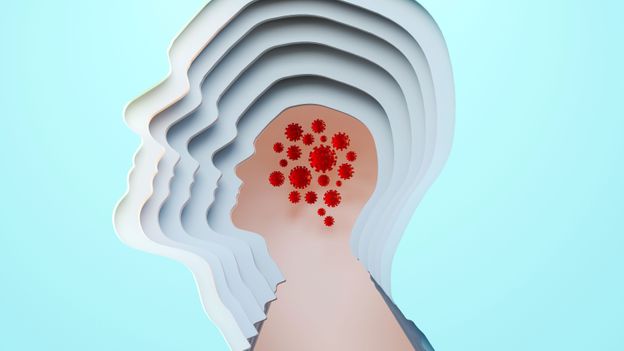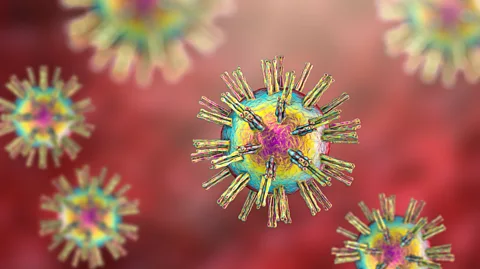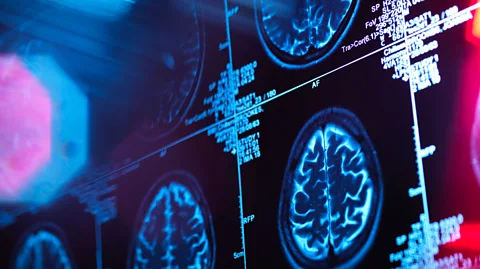The heretical and hopeful role of infection

 Getty Images
Getty ImagesWhat if dormant microbes trigger the onset of Alzheimer’s? It’s a theory that could have profound implications for prevention of the disease, writes David Robson.
It is more than 150 years since scientists proved that invisible germs could cause contagious illnesses such as cholera, typhoid, and tuberculosis. The role of microbes in these diseases was soon widely accepted, but “Germ Theory” has continued to surprise ever since – with huge implications for many apparently unrelated areas of medicine.
We may be witnessing a similar revolution in our understanding of Alzheimer’s disease. Lifestyle and genetic factors certainly play a role in the development of the illness. But it looks increasingly possible that some common viruses and bacteria – the kinds that give us cold sores and gum disease – may, over the long term, trigger the death of neural tissue and a steady cognitive decline. If so, infections may be one of the leading causes of the dementia.
Like the germ theories of ulcers and cancers, this hypothesis was once considered a kind of heresy – yet a string of compelling findings has sparked renewed interest in microbes’ contributions to dementia. “There’s a huge amount of work being done now, compared to even five years ago,” says Ruth Itzhaki, an emeritus professor at the University of Manchester in the UK, who has spent three decades investigating the role of infection in Alzheimer’s.
The hypothesis has inspired a clinical trial of a drug that could target the infection before it decimates the brain, radically reducing the risk of senility in old age. And there may soon be many other exciting new treatments in the pipeline.
A new understanding of Alzheimer’s disease could not come soon enough. While there are many forms of dementia, Alzheimer’s causes around 60-70% of cases. Globally, that amounts to around seven million people who have been newly diagnosed every year, who desperately need new treatments to slow their decline.
The disease takes its name from the German doctor Alois Alzheimer. In 1906, he noted the build-up of plaques in the brain of a 55-year-old woman, Auguste Deter, who had been suffering from memory decline, language problems and unpredictable behaviour. We now know that these plaques are made from a protein called amyloid beta, and they are thought to be toxic to brain cells and impair the synaptic connections that are important for neural signalling. The accumulation of amyloid beta plaques may also cause tangles of another protein, tau, to build within cells, which can itself lead to neuronal death, and it appears to be accompanied by widespread inflammation in the brain, which adds to the damage.
 Wikipedia
WikipediaThe “amyloid beta hypothesis” has inspired countless trials of drugs that aimed to break up these toxic plaques. Yet this research has ended in many disappointments, without producing the desired improvements in patients’ prognosis. This has led some to wonder whether the amyloid beta hypothesis may be missing an important part of the story. “The plaques that Alzheimer observed are the manifestation of the disease, not the cause,” says geriatrics scientist Tamas Fulop at the University of Sherbrooke in Canada.
Scientists studying Alzheimer’s have also struggled to explain why some people develop the disease while others don’t. Genetic studies show that the presence of a gene variant – APOE4 – can vastly increase someone’s chances of building the amyloid plaques and developing the disease. But the gene variant does not seal someone’s fate as many people carry APOE4 but don’t suffer from serious neurodegeneration. Some environmental factors must be necessary to set off the genetic time bomb, prompting the build-up of the toxic plaques and protein tangles.
Could certain microbes act as a trigger? That’s the central premise of the infection hypothesis.
Itzhaki has led the way with her examinations into the role of the herpes simplex virus (HSV1), which is most famous for causing cold sores on the skin around the mouth. Importantly, the virus is known to lie dormant for years, until times of stress or ill health, when it can become reactivated – leading to a new outbreak of the characteristic blisters.
While it had long been known that the virus could infect the brain – leading to a dangerous swelling called encephalitis that required immediate treatment – this was thought to be a very rare event. In the early 1990s, however, Itzhaki’s examinations of post-mortem tissue revealed that a surprising number of people showed signs of HSV1 in their neural tissue, without having suffered from encephalitis.
Importantly, the virus didn’t seem to be a risk for the people without the APOE4 gene variant, most of whom did not develop dementia. Nor did the presence of APOE4 make much difference to the risk of people without the infection. Instead, it was the combination of the two that proved to be important. Overall, Itzhaki estimates that the two risk factors make it 12 times more likely that someone will develop Alzheimer’s, compared to people without the gene variant or the latent infection in their brain.
 Getty Images
Getty ImagesItzhaki hypothesised that this was due to repeated reactivation of the latent virus – which, during each bout, invades the brain and somehow triggers the production of amyloid beta, until eventually, people start to show the cognitive decline that marks the onset of dementia. “I think there has to be repeated activation and accumulated damage to explain the long-term course of the disease.”
Itzhaki says that her findings were met with a high degree of scepticism by other scientists. “We had the most awful trouble getting it published.” Many assumed that the experiments were somehow contaminated, she says, leading to an illusory result. Yet she had been careful to avoid this possibility, and the apparent link between HSV1 infection and Alzheimer’s disease has now been replicated in many different populations.
One paper, published earlier this year, examined cohorts from Bordeaux, Dijon, Montpellier and rural France. By tracking certain antibodies, they were able to detect who had been infected with the herpes simplex virus. The researchers found that the infection roughly tripled the risk of developing Alzheimer’s in APOE4 carriers over a seven-year follow-up period – but had no effect in people who were not carrying the gene. “The herpes virus was only able to have a deleterious effect if there was APOE4,” says Catherine Helmer at the University of Bordeaux in France, who conducted the research.
 Getty Images
Getty ImagesKomaroff knows of no theoretical objections to the theory. “I haven’t heard anyone, even world-class Alzheimer’s experts who are dubious about the infection hypothesis, give a good reason why it has to be bunkum,” he adds. We simply need more studies providing direct evidence for the link, he says, to be able to convince the sceptics.
Scientists studying the infection hypothesis have also started making some headway in explaining the physiological mechanisms.
In the short term, this could be highly advantageous, preventing the infection from spiralling out of control so that it poses an immediate danger to someone’s life. But if the pathogen is repeatedly reactivated during times of stress, the amyloid beta could accumulate in the toxic plaques, harming the cells it is meant to be protecting.
 Getty Images
Getty ImagesHow the APOE4 gene variant fits into this process remains to be discovered. Perhaps it changes our cells’ susceptibility to an infection. Or perhaps it impairs the clean-up and repair of the neural damage after the pathogen has been deactivated. Either way, the consequence would be increased neural degeneration.
It may seem strange that humans would have evolved a defence system that could backfire in this way. But the risk of developing Alzheimer’s later in life – after we’ve already had a chance to reproduce – would have been far less important for the survival of our species than the immediate risk of a full-blown brain infection during our youth. “If amyloid beta is evolutionarily conserved, it probably has some function that’s good for the preservation of the species – and protecting against infections in the brain would certainly qualify as such a function,” says Komaroff. We may now be living with the consequences of a trade-off between the immediate, short-term protection and the long-term risk of chronic illness.
During the current pandemic, some scientists have started to worry that the coronavirus could increase the risk of dementia. As scientists from Mount Sinai School of Medicine, New York warned in the Journal of Alzheimer’s Disease last year: “It is possible that there may be an existing population who have become unknowingly predisposed to neurodegeneration through silent viral entry into the brain.”
Such findings ring alarm bells for Fulop. “Sars-Cov-2 may act exactly as HSV-1,” he proposes. Others – including Gopalakrishnan – are more cautious, however. “We have demonstrated that the virus can infect human neurons, and it can cause some sort of neuronal stress,” he says. “And this may have some unexpected effects.” Much more research will be necessary to assess any long-term risks for neurological disease.
 Getty Images
Getty ImagesThree decades after her initial investigations, Itzhaki hopes we will now see the development of more clinical trials testing new treatments, in a bid to replicate the observations of the HSV1 patients receiving antiviral medication in Taiwan.
One study in New York is already investigating the use of the anti-herpetic medication valacyclovir on patients with mild Alzheimer’s disease. The participants are set to undergo a series of cognitive tests after 52 and 78 weeks. If those receiving the drug experience a slower decline in performance than those receiving a placebo, it will provide some compelling evidence for the efficacy of the treatment – and the infection hypothesis more generally. “It’s the first trial of its kind,” says Itzhaki.
The success of anti-herpetic drugs could also spur efforts to treat the many other kinds of infections that may also contribute to Alzheimer’s risk in certain patients. Eventually, doctors may be able to screen people according to the many different microbes they may be carrying in their brains – and control the infections before they have time to cause serious damage.
During our conversation, Itzhaki repeatedly expresses her frustration that progress hasn’t come sooner. If these treatments help a fraction of the seven million people developing Alzheimer’s disease every year, they would have an enormous impact on world health.
“After these 30 years of difficulties getting funding and getting published, it strikes me very often how many people might have benefited if these treatments had been tested earlier,” she says. “I feel so strongly about that.”
Source link





